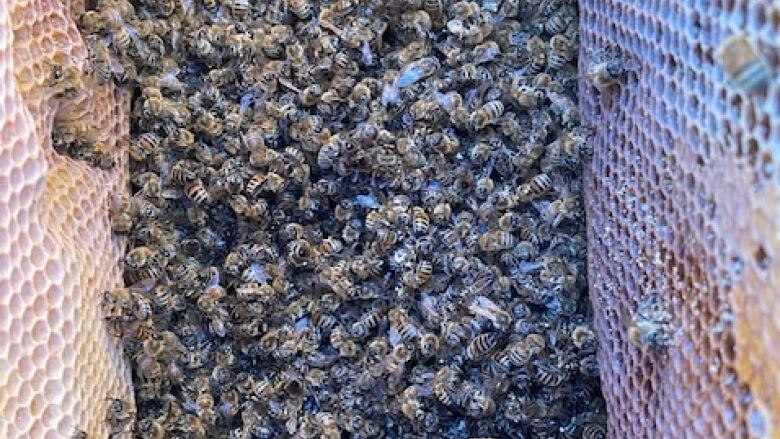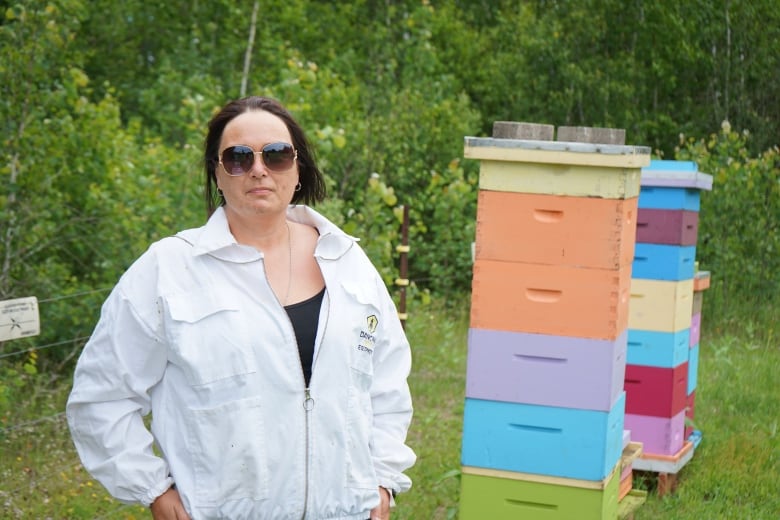Manitoulin Island beekeeper looking for answers after toxic herbicide detected in dead bees
Lab tests reveal higher-than-normal levels of glyphosate in bee colonies

Janice Mitchell was prepping her bee colonies for what she thought would be another regular winter season on Manitoulin Island.
Come February, Mitchell had a nasty surprise when she discovered that 90 per cent of her colonies had died.
"I'll frequently check my colonies and just listen outside the wraps and I knew something was up," said Mitchell, a hobby beekeeper and veterinarian.
"They were awfully quiet."
On average, Mitchell says at the height of her beekeeping, she had 25 colonies. Last year she only had 18, and about 16 had been decimated.
In previous years, the mortality rate for her colonies averaged around 10 per cent.
"It was my biggest loss. That's when I knew something had changed."

Mitchell opened up the dead bees for a necropsy and found no signs of starvation, mold or moisture problems, no signs of wing deformed virus, and minimal varroa mites a parasite of honey bees.
So, she sent them off for more testing at the University of Guelph's agriculture and food laboratory. Turns out, the lab detected 0.57 milligrams of glyphosate, a herbicide used to control troublesome weeds, in the dead bees.
Research from Europe's Pesticide Action Network says exposure to the herbicide in concentrations between five to 10 milligrams, similar to those found in the environment, reduces beneficial gut bacteria in honey bees and dysregulates their immune system.
LISTEN| Manitoulin beekeeper who lost 90 per cent of her colonies:

The acceptable level of glyphosate in drinking water for humans is 0.28 milligrams, according to Ontario's drinking water standards.
According to Mitchell, when she asked for a glyphosate test for her dead bees, she was told that the lab had never done that before.
"That was quite profound for me. I was thinking 'how are these chemicals getting approved and how are beekeepers not testing for this in bees' bodies?'" Mitchell said.

Now, she's spreading the word and ringing alarm bells for what this means for wild bees and pollination.
At this point, it's not clear where the chemicals came from. However, bees' radius for foraging is five kilometres.
Most farm fields in Ontario useglyphosate-based herbicides like Roundup, according toPaul Kelly, manager of the University of Guelph's Honey Bee Research Centre. He says the centre hasn't beenconcerned about its use or seen any problems in theirhives associated with glyphosate exposure.
"Most people don't feel that it's much of an issue," said Kelly.
"Now, it doesn'tmean that there couldn't be an unusual circumstance where bees are exposed to an unusual high amount, and it could have caused some kind of toxic event, but that's a very uncertain thing," he said.
Northern Ontario apiaries looking for answers
Last week, CBC News reported a story about a beekeeper in Lively, Ont. who is raising money to run tests and necropsies after she discovered 1.2 million bees suddenly dropped dead atMikkola Family Farm & Apiary.
Testing can only happen through auser-pay system.
Dawn Lalonde said allproceedswould go towardidentifying and eliminating the source of the problem.
The abrupt and violent nature of the deaths, combined with discussions with other local beekeepers, led her to conclude something in the environment could be to blame.
"It was an acute kill, which is most likely from some type of chemical used in the area," she said.

Ian Grant, president of the Ontario Beekeepers' Association, told CBC News thatmortality rates in apiaries have been particularly high coming out of the winter.
"This year we have been hearing about large losses in the beekeeping communityand we can't attribute it to any particular issue," he said.
However, Mitchell said education plays a important role in preventing bee deaths caused byagrochemicals.
"I pass the gauntlet to academia and researchers. This should be taken on and analyzed," said Mitchell.
With files from Bridget Yard












_(720p).jpg)


 OFFICIAL HD MUSIC VIDEO.jpg)
.jpg)



























































































